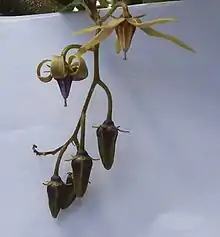Solanum melissarum
Solanum melissarum is a small tree or shrub in the flowering plant family Solanaceae endemic to Brazil.[3]
| Solanum melissarum | |
|---|---|
 | |
| Flower and flower buds | |
| Scientific classification | |
| Kingdom: | Plantae |
| Clade: | Tracheophytes |
| Clade: | Angiosperms |
| Clade: | Eudicots |
| Clade: | Asterids |
| Order: | Solanales |
| Family: | Solanaceae |
| Genus: | Solanum |
| Species: | S. melissarum |
| Binomial name | |
| Solanum melissarum Bohs | |
| Synonyms[2] | |
|
Cyphomandra divaricata (Mart.) Sendtn. | |
Description
A small tree, from 1 to 6 metres high, usually with a single trunk. The crown of light branches carries simple, unlobed leaves. The flowering inflorescence is from 5 cm to 30 cm long, and carries 4 to 20 long, narrow flower buds. The narrow, slightly membranous flower petal are green-white. The petals curve upward at first opening, and become lax as the flower ages. The anthers are at first purple, changing to yellow-orange with age.[3]
Reproductive biology
The pendulous flowers have poricidal anthers close to the stigma, with membranous thecae joined by a connective bearing osmophores that attract males of Euglossa cordata bees. As they collect fragrances, the bees press the thecae and pollen is released through a bellows mechanism. Based on the hand-pollination treatments, this species is self-incompatible.[4]
References
- World Conservation Monitoring Centre 1998. Solanum melissarum. 2006 IUCN Red List of Threatened Species. Downloaded on 23 August 2007.
- Bohs, Lynn (1995). "Transfer of Cyphomandra (Solanaceae) and its species to Solanum". Taxon. 44 (4): 583–587. doi:10.2307/1223500. JSTOR 1223500.
- Bohs, Lynn (1994). "Cyphomandra (Solanaceae)". Flora Neotropica. New York Botanical Garden. Monograph 63: 75–77.
- C. P. Coelho; D. C. Gomes; F. A. G. Guilherme; L. F. Souza (4 May 2017). "Biologia reprodutiva da endêmica Solanum melissarum Bohs (Solanaceae) e atualização da distribuição geográfica atual, como base para a sua conservação no Cerrado Brasileiro". Brazilian Journal of Biology. 77 (4): 809–819. doi:10.1590/1519-6984.01516. ISSN 1519-6984. PMID 28492799. Wikidata Q38792753.
| Wikimedia Commons has media related to Solanum melissarum. |
